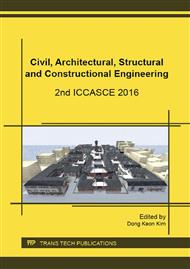p.91
p.98
p.104
p.111
p.119
p.125
p.131
p.137
p.145
Experimental Investigation on the Seismic Performance of a Chinese Traditional Wooden Pagoda
Abstract:
To investigate the seismic performance of the traditional Chinese timber structure, a one-fifth scale model of a seven-story pavilion-style wooden pagoda was tested on a shaking table. An artificial wave and two natural earthquake waves were used. Different excitation intensities ranging from frequent-met level to rare-met level of 7 degree as specified in Chinese code were mainly considered. White noise excitations were applied to obtain the change of the dynamic characteristics of the model. The identification results of dynamic characteristics indicated that the model’s damping ratio was more than 0.1, and the first natural frequency decreased by 17% with the corresponding damping ratio increased by 46% after the earthquake excitations. Typical components which including ludous and sandous were observed with splitting perpendicular- to-wood-grain under rare-met earthquake excitations, but other structural members were not found noticeable damage. The maximum acceleration amplification coefficient of the top point was 2.46, and the maximum displacement was 239 mm. Small residual deformation was detected under the rare-met earthquake excitations. The experiment implied the extraordinary seismic performance of such kind of structures.
Info:
Periodical:
Pages:
119-124
Citation:
Online since:
November 2016
Authors:
Price:
Сopyright:
© 2017 Trans Tech Publications Ltd. All Rights Reserved
Share:
Citation:


